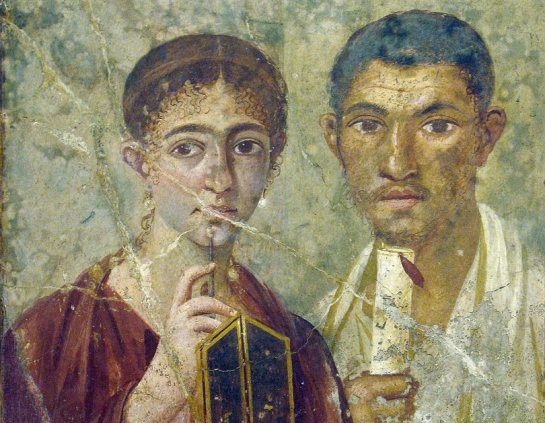Share it like Cicero: How Roman authors used social networking
One of the stories I tell in “Writing on the Wall” is about the way the Roman book-trade worked. There were no printing presses, so copying of books, which took the form of multiple papyrus rolls, was done entirely by hand, by scribes, most of whom were slaves. There were no formal publishers either, so Roman authors had to rely on word-of-mouth recommendations and social distribution of their works via their networks of friends and acquaintances.
It was crucial to choose the right person to dedicate the book to. The ideal candidate would be famous, influential and somewhat vain, so that he would be sure to mention the book to his friends, thus ensuring that people heard about it. He would also have an impressive library with plenty of traffic from visiting scholars and philosophers. The new book, prominently displayed in the library as a set of rolls in an elegant presentation box, would then be seen by people who might take pick up a papyrus roll and start reading it. If they were sufficiently impressed, they might ask the library’s owner for their own copy, which he would ask his scribes to produce. So the ideal dedicatee also needed a staff of reliable copyists. With luck, the original copy of the book would then produce offspring which would, in turn, end up in other libraries where they could be consulted and copied. The author might also put a few other copies of his book into circulation, giving them to friends and asking them to read them and pass them on, and make their own copies if they wanted to.HT: Kottke who also links to the recent NYT opinion piece on networking in Age of Reason England
This explains, in part, why Cicero dedicated his book “Academia” to Varro, a scholar and prolific author who had a large and popular library. On another occasion Cicero wrote a rather fawning letter to his well-placed contemporary Quintus Cornificius, asking him to endorse one of his books and recommend it to his friends. But endorsements were not the only way to generate interest in a new book. Cicero’s friend Atticus hosted dinner parties for him, at which excerpts, or sometimes even an entire book, would be read out (“whenever I write anything, I shall entrust the advertising to you”, Cicero told him). By the end of the first century BC a more formal way to announce and promote a new book, called the recitatio, had established itself. This was a launch party at which a book (or excerpts from it) were read to an invited audience, either by the author or by a skilled slave known as a lector. Once the reading was over, a presentation copy of the book would be given to the dedicatee, and other less fancy copies would be made available to the author’s friends and associates. The work was then considered to have been published, in the sense that it had been formally released by its author for reading, copying and circulation. At that point the book was on its own and would either spread — or not, depending on whether the author had succeeded in generating sufficient buzz....MORE
.
